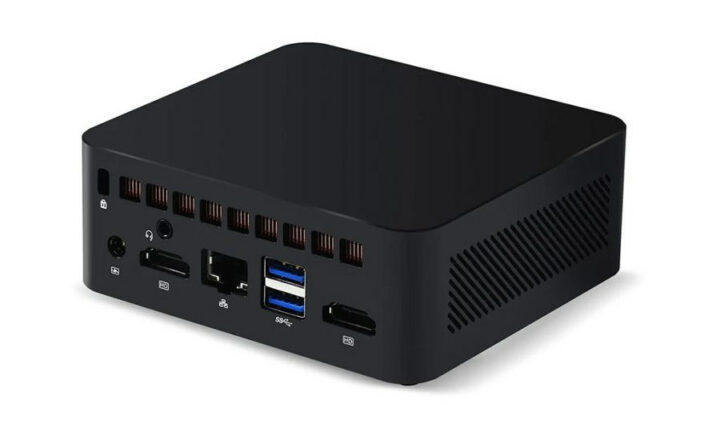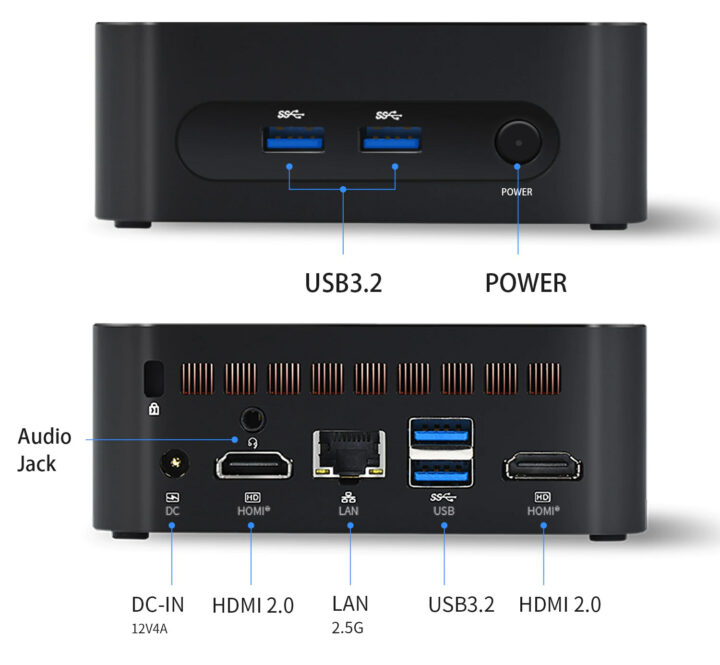We’ve started to see Intel Alder Lake-N processors in mini PCs such MSI Cubi ADL N and Morefine M9 based on announced SKUs, but the Intel Processor N95 processor, which Intel has yet to unveil, is now found in a mini PC sold for various Aliexpress sellers starting at $187 for a barebone system and going up to $384 for a model with 32GB RAM and a 1TB SSD preloaded with an activation version of Windows 10 or Windows 11.
The Processor N95 is a quad-core processor clocked at up to 3.4 GHz (Turbo) with 6MB cache, and 16EU Intel UHD graphics clocked up to 1.2 GHz. The 15W processor’s base frequency is shown to be 1.7 GHz in GeekBench while the 6W Alder Lake-N processors have a sub-GHz base frequency. That could mean the CPU performance is quite higher than the 6W N100 and N200 parts, but the GPU performance might end up being similar, or a little bit higher with 16 execution units @ 1.2 GHz instead of 24 EU @ 750 MHz.
Specifications:
- SoC – Intel Processor N95 quad-core Alder Lake-N processor @ up to 3.4 GHz (Turbo) with 6MB cache, 16EU Intel HD graphics @ 1.2 GHz; TDP: 15W
- System Memory – 8GB, 16GB, or 32GB DDR4
- Storage
- 128GB, 256GB, 512GB, or 1TB M.2 NVMe SSD
- M.2 2242 SATA socket
- Video Output – 2x HDMI 2.0b ports up to 4Kp60; dual independent display support
- Audio – 1x audio jack
- Networking
- 2.5GbE RJ45 port via Intel i225-V controller
- Wi-Fi 5 and Bluetooth 4.2 AC7265 wireless module
- USB – 4x USB 3.2 ports
- Misc
- Power button
- Kensington lock slot
- “Silent fan”, heatsink, and heat conduction plate for cooling
- Additional features: “network wakeup and power on” which I understand as WoL and auto power on…
- Power Supply – 12V/4A via DC jack
- Dimensions – 113 x 106 x 42mm
- Weight – 240 grams
The dimensions, weight, and port arrangement is exactly the same as for the Morefine M9 we covered yesterday. But there are differences beyond the processor used, since the Processor N95 mini PC offers 2.5GbE networking, and does without WiFi 6, relying instead on a WiFi 5 module. This model also comes with a beefier 12V/4A (48W) power supply, and it looks to be a better option for people who would rather have a (potentially) faster CPU and 2.5Gbps Ethernet networking.
Via Liliputing

Jean-Luc started CNX Software in 2010 as a part-time endeavor, before quitting his job as a software engineering manager, and starting to write daily news, and reviews full time later in 2011.
Support CNX Software! Donate via cryptocurrencies, become a Patron on Patreon, or purchase goods on Amazon or Aliexpress







Stupid naming, ‘N’, based on ‘E’ cores.
What if journalists just call it ‘Atom’ and people with understand it contains cores with a -mont?
Juxtaposed with the Core i3/5/7/9 with hybrid cores based on Lakes and Monts.
But no, Intel had to screw it up and name an 8-core Mont a Core i3.
#firstworldproblems
Def a first world problem to care about the names. Although the Coof CPU is too funny.
What’s really important now is the reviews. We need to see how it compares to Jasper Lake and what’s the deal with the memory.
I think a 10-20% improvement in CPU performance for a N95 vs the N6005 is a reasonable expectation.
Even if I consider Geekbench results somewhat questionable looking through the individual tests hints at least at something (IMO some IPC improvements that generate wins in areas like machine learning but obviously N95 can burst only for fractions of time – see also comment below comparing N95 and N100):
https://browser.geekbench.com/v5/cpu/compare/20046753?baseline=19288841
The Aliexpress page claims a 35% overall performance improvement over N5105/N6000. We probably need some proper testing to sort this out.
Here we go again: Another N95 vs. N6005.
This time N95 is obviously able to burst at 3.4GHz at least single-threaded for the whole duration. Multi-threaded the clockspeeds must be ~30% lower then.
As you said: ‘proper testing’ needed and Geekbench is unfortunately the opposite: test execution times way too short and silly relying on bogus metadata instead of actually measuring and reporting real CPU clockspeeds.
Intel’s nonsensical-naming is not first world problem IMO.
This affect all everyone especially non tech consumer.
Many previous i3 user (in developed/developing countries) will regret their “upgrade”.
Although i have yet to test i3-N300, but if my experience is anything to go by a small/celeron/atom core perf is lower than their 2 year old big/i-cores.
naming it i3 means some layman consumer will be duped into thinking that this new cpu is an upgrade to their old 12/11th Gen i3.
the process node name is also confusing.
Process 7 is confusing & bordering on lies, it is a 10nm+++ process, even though somesays its equal to their competitor 7nm.
then there is also xeon naming scheme.
> Process 7 is confusing & bordering on lies, it is a 10nm+++ process
Same goes for every other semiconductor manufacturer claiming ‘structures less than 28nm thick’. RK3588 for example is said to be made in an ‘8nm process’ while it’s most probably Samsung’s 8LPP (an extension of Samsung’s 10LPP process and said to have a fin pitch of 42nm and gate pitch of 64nm. No 8s were harmed in the making of the silicon)
Same goes for TSMC where even its vice president of corporate research had to tell the audience: TSMC’s 7nm, 5nm, and 3nm “are just numbers… it doesn’t matter what the number is”
Though TSMC’s marketing people of course babbled of ‘7nm’ when sending out press releases praising their then new ‘7N’ process. And this still works: TSMC talks about a new node variant called ‘3N’ and bloggers and press talk about ‘process: 3nm’ for no other reason themselves adding an ‘m’ to ‘3n’.
> naming it i3 means some layman consumer will be duped into thinking
Those consumers I know have no idea which CPU is inside their laptops or tablets. Majority has not even an idea what a CPU is. They ask friends/family for advice and hopefully those read reviews first instead of blindly trusting into a ‘classification system’ made by a marketing department (since that’s a little dumb, isn’t it?)
> if my experience is anything to go by a small/celeron/atom core perf is lower than their 2 year old big/i-cores.
Single-threaded for sure! @Linuxium already benchmarked the E cores here for a Mini PC review. 7-ZIP MIPS as follows: E-core @ 3.3 GHz: 4020, P-core @ 4.4 GHz: 5300. These i3-N30x burst at 3.8 GHz so their cores are slightly faster, there are eight of them and compared to former ‘small/celeron/atom core’ Gracemont supports AVX, AVX2 and AVX-VNNI instructions.
> That would mean the CPU performance should be quite higher than the 6W N100 and N200 parts
Huh? IMO it means that N95 is the garbage scraped from the wafers that still somewhat reliably runs heavily overvolted. Geekbench seems to confirm this with N95 showing less than 80% of N100’s performance.
Since it’s in every area I would suspect N95 can burst to the advertised 3.4 GHz for approximately 13 nanoseconds to then drop down to safer values south of 3.0 GHz.
In some cases listed TDP is higher than the actual power consumption, even at full load. The Pentium Gold G5400 has a TDP of “58 W” but in reality shouldn’t hit the 30W mark at full load.
But that obviously depends somewhat on silicon lottery, like you mentioned those lower end chips have the shittiest of the shittiest silicon and there’s probably quite a lot of variance there.
https://ark.intel.com/content/www/us/en/ark/products/129951/intel-pentium-gold-g5400-processor-4m-cache-3-70-ghz.html
https://www.gamersnexus.net/hwreviews/3302-intel-pentium-g5600-review-benchmarks-vs-amd-ryzen-3-1300x
The “15W” is plausible with 4 gracemont cores @ 3 ghz. Even with non-perfect silicon. But I doubt it can stay at 3ghz with the iGPU being loaded too. And there’s likely a big amount of variance between chips.
Call me naive, but I still thought TDP had some meaning in the sense a CPU from the same family with a higher TDP should deliver higher performance just because of the higher power budget. But it would make sense that N95 is slower than N100 because 95 < 100…
Just tried to collect what we ‘know’ (relying on correctness of ARK and trusting into Geekbench reporting “Base frequency” correctly):
* N50: 2C, 3400 MHz / ? MHz @ 6W
* N95: 4C, 3400 MHz / 1700 MHz @ ?
* N97: 4C, 3400 MHz / ? MHz @ 12W
* N100: 4C, 3400 MHz / 800 MHz @ 6W
* N200: 4C, 3700 MHz / 1000 MHz @ 6W
* N300: 8C, 3800 MHz / 800 MHz @ 7W
* N305: 8C, 3800 MHz / 1800 MHz @ 15W
With that jumping Base Frequencies IMO the only valid conclusion is this: N200 being more energy efficient than N100 (and slightly faster as well).
Intel Processor N95 details are on Ark https://www.intel.com/content/www/us/en/products/sku/231800/intel-processor-n95-6m-cache-up-to-3-40-ghz/specifications.html?wapkw=n95
The GPU is clocked at 1.2GhHz instead of 750MHz